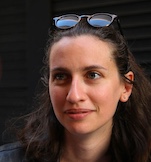
DUBIED Morgane
Post-doctorant : BAH
Université Lyon 1
CNRS, UMR 5023 - LEHNA,
Laboratoire d'Ecologie des Hydrosystèmes Naturels et Anthropisés
6, rue Raphaël Dubois - Bât. Forel
F-69622 Villeurbanne Cedex FRANCE
Cette adresse e-mail est protégée contre les robots spammeurs. Vous devez activer le JavaScript pour la visualiser.


Mes travaux de recherche en paléontologie et biologie évolutive porte sur l'évolution et le développement du complexe crânio-facial chez les rongeurs, c'est-à-dire le positionnement des différents tissus (os, muscles, dents, organes internes) au cours de la croissance. J’aborde la question des changements de conformation des différents tissus au cours du développement à la fois à l'échelle microévolutive (au niveau de la famille) et à l'échelle macroévolutive (au niveau de l'ordre). L'objectif est de mieux comprendre l'implication des changements de forme dans les processus évolutifs qui ont conduit à la diversité d'un groupe. Il est également important pour moi de prendre en compte les traits d'histoire de vie résultant de l'histoire adaptative des différents taxons étudiés. Ainsi, mes recherches s'articulent autour de plusieurs axes :
- L'évolution de la forme du crâne et de la mandibule ainsi que la covariation de ces deux unités au cours du développement, c'est-à-dire la synchronisation ou non du changement de forme ;
- L'influence de la croissance des différents tissus sur ces changements de forme
forme ;
- L'implication de ces modèles de développement dans l'histoire évolutive du rongeur ;
- La comparaison entre la macroévolution et la microévolution ;
- L'implication des traits d'histoire de vie dans les processus d'évolution.
My research in paleontology and evolutionary biology focuses on the evolution and development of the craniofacial complex in rodents, i.e. the positioning of different tissues (bones, muscles, teeth, internal organs) during growth. I address the question of changes in the conformation of different tissues during development at both microevolutionary (family level) and macroevolutionary (order level) scales. The aim is to better understand the involvement of shape changes in the evolutionary processes that have led to group diversity. It is also important for me to take into account the life-history traits resulting from the adaptive history of the different taxa studied. Thus, my research focuses on several areas:
- The evolution of the skull and mandible shape, and the covariation between these two units during development, i.e. whether or not the change in shape is synchronized;
- The influence of tissue growth on these shape changes shape ;
- The implication of these developmental patterns in the evolutionary history of the rodent;
- The comparison between macroevolution and microevolution;
- The implication of life-history traits in evolutionary processes.
2023
- Montillot, C., Skutunova, E., Dubied, M., Lahmar, A., Nguyen, S., Peerally, B., Prin, F., Duffourd, Y., Thauvin-Robinet, C., Duplomb, L., Wang, H., Ansar, M., Faivre, L., Navarro, N., Minocha, S., Collins, S.C. & Yalcin, B. Characterization of Vps13b-mutant mice reveals neuroanatomical and behavioral phenotypes with females less affected. Neurobiology of Disease, 106259.
2022
- Dubied, M., Montuire, S., & Navarro, N. Functional constraints channel mandible shape ontogenies in rodents. Royal Society Open Science, 9(220352), 220352.
2021
- Bonfante, B., Faux, P., Navarro, N., Mendoza-Revilla, J., Dubied, M., Montillot, C., Wentworth,E., Poloni, L., Varon-Gonzalez, C., Jones, P., Xiong, Z., Fuentes-Guajardo, M., Palmal, S., Chacon-Duque, J.C., Hurtado, M., Villegas, V., Granja, V., Jaramillo, C., Arias, W., Barquera, R., Everardo-Martinez, P., Sanchez-Quinto, M., Gomez-Valdés, J., Villamil-Ramirez, H., Silva de Cerqueira, C.C., Hünemeier, T., Ramallo, V., Liu, F., Weinberg, S.M., Shaffer, J.R., Stergiakouli, E., Howe, L.J., Hysi, P.G., Spector, T.D., Gonzalez-José, R., Schüler-Faccini, L., Bortolini, M.-C., Acuna-Alonzo, V., Canizales-Quinteros, S., Gallo, C., Poletti, G., Bedoya, G., Rothhammer, F., Thauvin-Robinet, C., Faivre, L., Costedoat, C., Balding, D., Cox, T., Kayser, M., Duplomb, L., Yalcin, B., Cotney, J., Adhikari, K. & Ruiz-Linares, A. A GWAS in Latin Americans identifies novel face shape loci, implicating VPS13B and a Denisovan introgressed region in facial variation. Science advances, 7(6), eabc6160.
- Dubied, M., Solé, F., & Mennecart, B. Endocranium and ecology of Eurotherium theriodis, a European hyaenodont mammal from the Lutetian. Palaeontologia Polonica, 66(3).
- Dubied, M., Solé, F., & Mennecart, B. 3D models related to the publication: Endocranium and ecology of Eurotherium theriodis, a European hyaenodont mammal from the Lutetian. MorphMuseuM, 4, e84.
- Dubied, M., Montuire, S., & Navarro, N. Commonalities and evolutionary divergences of mandible shape ontogenies in rodents. Journal of Evolutionary Biology, 34(10), 1637-1652.
2020
- Selden Jr, R. Z., Dockall, J. E., & Dubied, M. A quantitative assessment of intraspecific morphological variation in Gahagan bifaces from the southern Caddo area and central Texas. Southeastern Archaeology, 39(2), 125-145.
2019
- Dubied, M., Solé, F., & Mennecart, B. The cranium of Proviverra typica (Mammalia, Hyaenodonta) and its impact on hyaenodont phylogeny and endocranial evolution. Palaeontology, 62(6), 983-1001.
- Dubied, M., Solé, F., & Mennecart, B. 3D models related to the publication: The cranium of Proviverra typica (Mammalia, Hyaenodonta) and its impact on hyaenodont phylogeny and endocranial evolution. MorphMuseuM, 4, e74.
2018
- Solé, F., Dubied, M., Verger, K. L., & Mennecart, B. Niche partitioning of the European carnivorous mammals during the Paleogene. Palaios, 33(11), 514-523.
- Solé, F., Dubied, M., Le Verger, K., & Mennecart, B. 3D models related to the publication: Niche partitioning of the European carnivorous mammals during the Paleogene. MorphMuseuM, 4, e63.
2017
- Dubied, M., Gilbert, C., Deléglise, M., Laurens, F., & Mennecart, B. De l’importance de la collection Quatrehomme (Musée La Monnaye, Meung-sur-Loire) dans le paysage paléontologique français. Carnets Geol., 17(05), 129.































